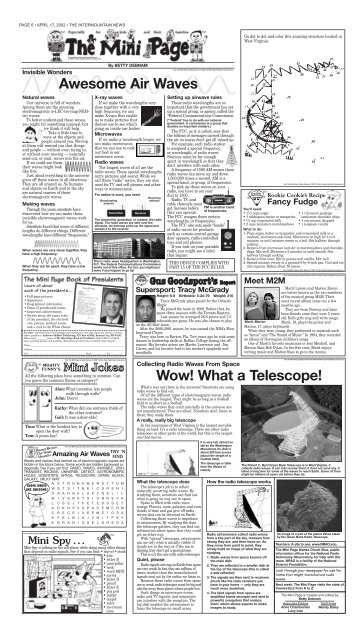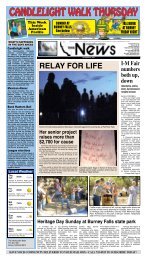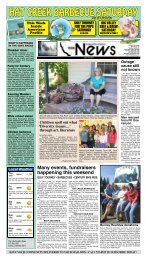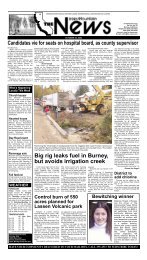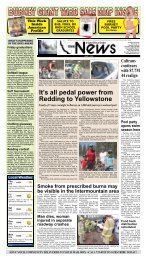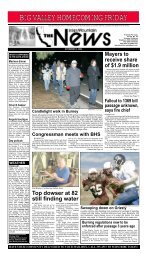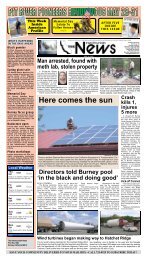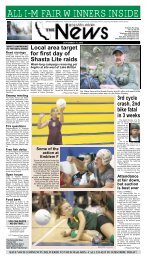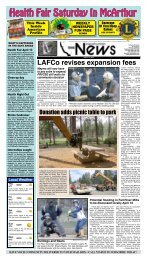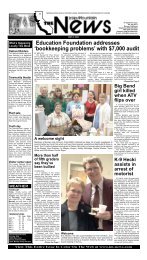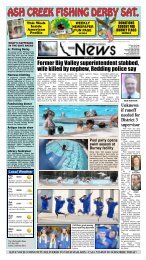Graham accepts new post - Intermountain News
Graham accepts new post - Intermountain News
Graham accepts new post - Intermountain News
You also want an ePaper? Increase the reach of your titles
YUMPU automatically turns print PDFs into web optimized ePapers that Google loves.
PAGE 6 • APRIL 17, 2002 • THE INTERMOUNTAIN NEWS<br />
p<br />
TM<br />
TM<br />
Go dot to dot and color this amazing structure located in<br />
West Virginia.<br />
Distributed by Universal Press Syndicate<br />
© 2002 The Mini Page Publishing Company Inc.<br />
Natural waves<br />
Our universe is full of wonders.<br />
Among them are the amazing<br />
electromagnetic (e-LEC-tro-mag-NEHtic)<br />
waves.<br />
To better understand these waves,<br />
you might try something unusual, but<br />
we think it will help.<br />
Take a little time to<br />
wave at the objects and<br />
people around you. Waving<br />
at them will remind you that things<br />
and people — without even trying to,<br />
or without even moving — naturally<br />
send out, or emit, waves into the air.<br />
If we could see them,<br />
their waves might look<br />
like this.<br />
Just about everything in the universe<br />
gives off these waves in all directions.<br />
They are all around us. So humans<br />
and objects on Earth and in the sky<br />
are natural sources of these<br />
electromagnetic waves.<br />
Making waves<br />
Through the years, scientists have<br />
discovered how we can make these<br />
invisible electromagnetic waves work<br />
for us.<br />
Scientists found that waves of different<br />
lengths do different things. Different<br />
wavelengths have different “frequencies.”<br />
When waves are very close together, they<br />
have a high frequency.<br />
When they are far apart, they have a low<br />
frequency.<br />
By BETTY DEBNAM<br />
Invisible Wonders<br />
Awesome Air Waves<br />
Learn all about<br />
each of the presidents…<br />
• Full-page pictures<br />
• Signatures<br />
• Biographical information<br />
• Dates of presidential terms<br />
• Important achievements<br />
• Stories about the many roles<br />
of the president, the electoral<br />
vote process, political terms,<br />
and a visit to the White House!<br />
from The Mini Page by Betty Debnam © 2002 The Mini Page Publishing Company Inc.<br />
Mini Spy ...<br />
X-ray waves<br />
If we make the wavelengths very<br />
close together with a very<br />
high frequency, we can<br />
make X-rays that enable<br />
us to make pictures that<br />
doctors use to see what’s<br />
going on inside our bodies.<br />
Microwaves<br />
If we make a wavelength longer, we<br />
can make microwaves<br />
that we can use to cook<br />
our food in our<br />
microwave ovens.<br />
Radio waves<br />
The longest waves of all are the<br />
radio waves. These special wavelengths<br />
carry pictures and sound. While we<br />
call them “radio” waves, they are also<br />
used for TV and cell phones and other<br />
ways to communicate.<br />
For radios to work, you need:<br />
Broadcasting<br />
antenna<br />
Transmitter<br />
To order, send $4.95 plus $1.50 <strong>post</strong>age and handling for each copy. Send only checks or money<br />
orders payable to: Andrews McMeel Publishing, P.O. Box 419242, Kansas City, MO 64141.<br />
Please send _________ copies of The Mini Page Book of Presidents (Item #7807-0) at $6.45<br />
each, including <strong>post</strong>age and handling. (Bulk discount information available upon request.)<br />
Name: ____________________________________________________________________________________<br />
Address: __________________________________________________________________________________<br />
City: ___________________________________________________ State: ____________ Zip: ___________<br />
TM<br />
TM<br />
Basset Brown<br />
The <strong>News</strong><br />
Hound’s<br />
TRY ’N<br />
Amazing Air Waves<br />
FIND<br />
Words and names that remind us of electromagnetic waves are<br />
hidden in the block below. Some words are hidden backward or<br />
diagonally. See if you can find: RADIO, WAVES, INVISIBLE, DISH,<br />
TRANSMIT, RECEIVE, UNIVERSE, DETECT, ASTRONOMERS,<br />
HOLES, SCIENTISTS, SPACE, TELESCOPE, STARS, BLACK,<br />
GALAXY, MILKY WAY.<br />
RADIO WAVES<br />
ARE AWESOME!<br />
A S T R O N O M E R S T T U M<br />
W S T S I T N E I C S R E N I<br />
D A A H G A L A X Y Q A L I L<br />
B I V S R A T S I U B N E V K<br />
L C S E J T C E T E D S S E Y<br />
A D K H S V S P A C E M C R W<br />
C R E C E I V E E M Z I O S A<br />
K F E L B I S I V N I T P E Y<br />
K G R A D I O S E L O H E O A<br />
Mini Spy is talking on her cell phone while doing many other things<br />
that depend on radio signals. See if you can find: • shovel • steak<br />
• kite<br />
• letter B<br />
• caterpillar<br />
• book<br />
• word MINI<br />
• carrot<br />
• letter D<br />
• pencil<br />
• letter E<br />
• pea pod<br />
• ladder<br />
• teapot<br />
• ruler<br />
• ice-cream<br />
cone<br />
Receiver<br />
Receiving<br />
antenna<br />
The transmitter generates, or creates, the radio<br />
signal. The radio waves are sent over the<br />
airwaves. An antenna picks up the signal and<br />
passes it to the receiver.<br />
This is radio wave headquarters in Washington,<br />
D.C. The Federal Communications Commission<br />
works out of this office. For fun, you might just<br />
wave if you happen to go by!<br />
from The Mini Page by Betty Debnam © 2002 The Mini Page Publishing Company Inc.<br />
All the following jokes have something in common. Can<br />
you guess the common theme or category?<br />
Tina: What is the hardest key to<br />
open the door with?<br />
Tom: A piano key!<br />
Alan: What invention lets people<br />
walk through walls?<br />
John: Doors!<br />
86<br />
George W. Bush<br />
Kathy: What did one entrance think of<br />
the other entrance?<br />
Gail: It was a-door-able!<br />
from The Mini Page by Betty Debnam © 2002 The Mini Page Publishing Company Inc.<br />
TM<br />
TM<br />
from The Mini Page by Betty Debnam © 2002 The Mini Page Publishing Company Inc.<br />
Setting up airwave rules<br />
These radio wavelengths are so<br />
important that the government has set<br />
up a special group, or agency, called the<br />
*Federal Communications Commission.<br />
(*“Federal” has to do with our national<br />
government. A commission is a group that<br />
decides on important matters.)<br />
The FCC, as it is called, sees that<br />
the billions of messages carried through<br />
the air on waves don’t get all mixed up.<br />
For example, each radio station<br />
is assigned a special frequency,<br />
or wavelength, of radio waves.<br />
Stations must be far enough<br />
apart in wavelength so that they<br />
don’t interfere with each other.<br />
A frequency of 1500 AM means these<br />
radio waves can move up and down<br />
1,500,000 times a second. AM is a<br />
special band, or group, of frequencies.<br />
To pick up those waves on your<br />
radio, you have to set your<br />
dial to 1500.<br />
Radio, TV and<br />
cable channels must<br />
get licenses before<br />
they can operate.<br />
The FCC assigns them certain<br />
wavelengths, or frequencies.<br />
The FCC also sets aside “bands”<br />
of radio waves for products<br />
such as remote-control garage<br />
door openers, radio-controlled<br />
toys and cell phones.<br />
If you look on your portable<br />
radio, you might see a label<br />
that begins:<br />
FM is another band<br />
of frequencies.<br />
THIS DEVICE COMPLIES WITH<br />
PART 15 OF THE FCC RULES.<br />
What’s way out there in the universe? Scientists are using<br />
radio waves to find out.<br />
Of all the different types of electromagnetic waves, radio<br />
waves are the longest. They might be as long as a football<br />
field or as short as a football.<br />
The radio waves that occur naturally in the universe are<br />
not manufactured. They are silent. Scientists don’t listen to<br />
them; they study them.<br />
A really, really big telescope<br />
In the mountains of West Virginia is the largest movable<br />
thing on land. It’s a radio telescope. There are other radio<br />
telescopes in other parts of the world, but this is the largest<br />
one that moves.<br />
TM<br />
from The Mini Page by Betty Debnam © 2002 The Mini Page Publishing Company Inc.<br />
Rookie Cookie’s Recipe<br />
Fancy Fudge<br />
You’ll need:<br />
• 11/2 cups sugar<br />
• 1 tablespoon butter or margarine<br />
• 1/2 cup evaporated milk<br />
• 2 cups miniature marshmallows<br />
How the radio telescope works<br />
Radio astronomers collect radio waves<br />
from a tiny part of the sky, measure how<br />
strong they are, and then move on. As<br />
they move from point to point, they<br />
slowly build an image of what they are<br />
studying.<br />
1. Radio waves from space bounce off<br />
the main dish.<br />
2. They are reflected to a smaller dish at<br />
the top of the telescope (this is called<br />
a sub-reflector).<br />
3. The signals are then sent to receivers<br />
(much like the radio receivers you<br />
have in your home — only they are<br />
much more sensitive).<br />
4. The faint signals from space are<br />
amplified (made stronger) and sent to<br />
powerful computers that analyze<br />
them, which allows experts to make<br />
images to study.<br />
• 1 (12-ounce) package<br />
semisweet chocolate chips<br />
• 1 cup pecans, chopped<br />
• 1 teaspoon vanilla<br />
What to do:<br />
1. Place sugar, butter or margarine and evaporated milk in a<br />
medium, microwave-safe bowl. Microwave on high for 4 to 6<br />
minutes, or until mixture comes to a boil. Stir halfway through<br />
cooking.<br />
2. Remove from microwave and stir in marshmallows and chocolate<br />
chips. Mix well. Microwave 2 minutes or until smooth. Stir<br />
halfway through cooking.<br />
3. Remove from oven. Stir in pecans and vanilla. Mix well.<br />
4. Spread mixture evenly in a greased 8-by-8-inch pan. Cool and cut<br />
into squares. Makes about 16 pieces.<br />
from The Mini Page by Betty Debnam © 2002 The Mini Page Publishing Company Inc.<br />
Meet M2M<br />
from The Mini Page by Betty Debnam © 2002 The Mini Page Publishing Company Inc.<br />
Marit Larsen and Marion Raven<br />
are better known as the two members<br />
of the musical group M2M. Their<br />
most recent album came out a few<br />
months ago.<br />
They are from Norway and have<br />
been friends since they were 5 years<br />
old. Both girls sing and write songs.<br />
Marit, 18, plays the guitar and<br />
Marit, Marion<br />
Marion, 17, plays keyboards.<br />
When they were young, they performed in musicals such<br />
as “Annie” and “The Sound of Music.” In 1994, they recorded<br />
an album of Norwegian children’s songs.<br />
One of Marit’s favorite musicians is Joni Mitchell, and<br />
Marion likes Bob Dylan. In her free time, Marit enjoys<br />
writing music and Marion likes to go to the movies.<br />
from The Mini Page by Betty Debnam © 2002 The Mini Page Publishing Company Inc.<br />
Collecting Radio Waves From Space<br />
Wow! What a Telescope!<br />
What the telescope does<br />
The telescope’s job is to collect<br />
naturally occurring radio waves. By<br />
studying them, scientists can find out<br />
what is going on way out in space.<br />
Space is filled with radio wave<br />
energy. Planets, stars, galaxies and even<br />
clouds of dust and gas give off radio<br />
waves that can be detected on Earth.<br />
Collecting these waves is important<br />
to astronomers. By studying the data<br />
the telescope gathers, they can find out<br />
information about space that they could<br />
get no other way.<br />
With “optical” telescopes, astronomers<br />
can see only what is actually visible. If<br />
clouds are in the way, or if the sun is<br />
shining, they don’t get a good picture.<br />
This is not the case with radio telescopes.<br />
Quiet, please<br />
Radio signals arriving on Earth from space<br />
are very weak. In fact, they are millions of<br />
times weaker than the manufactured<br />
signals sent out by the radios we listen to.<br />
Because these radio waves from space<br />
are so weak, radio telescopes must be big and<br />
also far away from places where people live.<br />
Such things as microwave ovens,<br />
radio and TV signals, and computers<br />
can interfere with the reception. The<br />
big dish enables the astronomers to<br />
focus the telescope on small areas.<br />
from The Mini Page by Betty Debnam © 2002 The Mini Page Publishing Company Inc.<br />
Supersport: Tracy McGrady<br />
Height: 6-8 Birthdate: 5-24-79 Weight: 210<br />
Tracy McGrady plays guard for the Orlando<br />
Magic.<br />
He joined the team in 2000. Before that, he<br />
spent three seasons with the Toronto Raptors.<br />
Last season he averaged 26.8 points and 7.5<br />
rebounds per game. He was also chosen to play<br />
on the All-Star team.<br />
After the 2000-2001 season, he was named the NBA’s Most<br />
Improved Player.<br />
Tracy was born in Bartow, Fla. Two years ago he took some<br />
classes in leadership skills at Rollins College during the offseason.<br />
His favorite actors are Martin Lawrence and Jim<br />
Carrey, and his favorite food is his mother’s spaghetti and<br />
meatballs.<br />
It is very tall, almost as<br />
tall as the Washington<br />
Monument. Its dish is<br />
about 300 feet across<br />
(about the length of a<br />
football field).<br />
The telescope is taller<br />
than the Statue of<br />
Liberty.<br />
The Robert C. Byrd Green Bank Telescope is in West Virginia. It<br />
collects radio waves. It can only receive them; it does not send any. It<br />
takes a long time for some of the waves to reach Earth. Some of them<br />
might be millions of years old before they do.<br />
An image of a part of the planet Venus taken<br />
by the Green Bank Radio Telescope.<br />
Teachers: A site to see: www.NRAO.edu.<br />
The Mini Page thanks Chuck Blue, public<br />
information officer for the National Radio<br />
Astronomy Observatory, for help with this<br />
issue. NRAO is a facility of the National<br />
Science Foundation.<br />
Look through your <strong>new</strong>spaper for ads for<br />
items that might manufacture radio<br />
waves.<br />
Next week, The Mini Page visits the state of<br />
Connecticut from A to Z.<br />
The Mini Page is created and edited by<br />
Betty Debnam<br />
Associate Editors<br />
Anne Chamberlain<br />
Lucy Lien<br />
Staff Artist<br />
Wendy Daley


